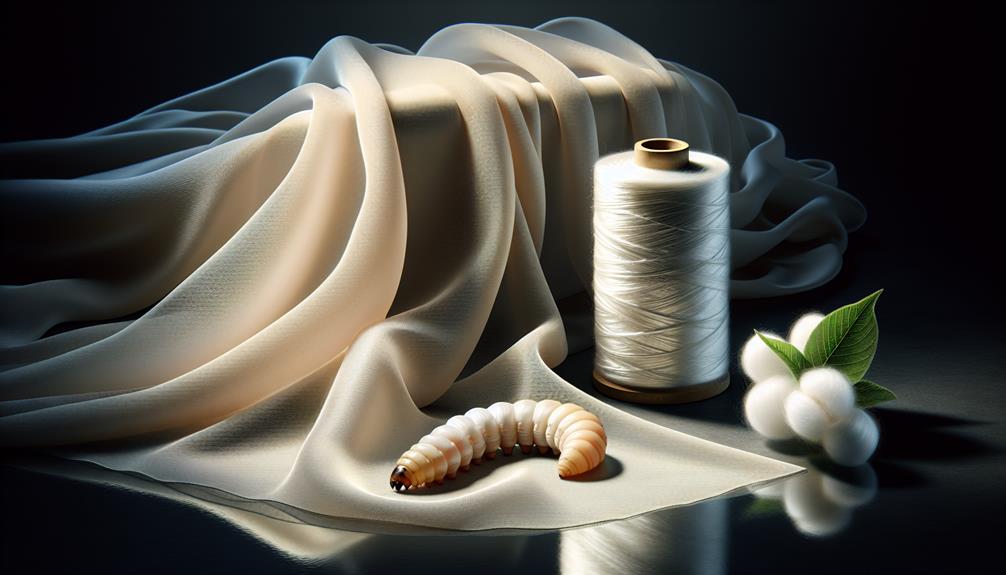No, chiffon isn't always made from silk. I've learned that it can also be made from synthetic materials like polyester or nylon. Originally, chiffon was exclusively silk, giving it a luxurious feel and elegant drape. However, with advancements in textiles, manufacturers now often use polyester and nylon to make chiffon because they're durable, less expensive, and easier to maintain. These synthetic versions of chiffon still offer a similar graceful appearance but with added practical benefits. Exploring the differences between these types can reveal more about what each material offers in fashion and care.
Table of Contents
Key Takeaways
- Chiffon is not always silk; it can also be made from polyester, nylon, or rayon.
- Silk chiffon is known for its luxurious feel and natural sheen.
- Polyester and nylon chiffon are more durable and easier to care for than silk chiffon.
- Synthetic chiffons like polyester and nylon are cost-effective alternatives to silk chiffon.
- Each type of chiffon, whether silk or synthetic, has unique properties suitable for different fashion needs.
Understanding Chiffon Fabric
Chiffon is a lightweight, sheer fabric known for its elegant drape and soft finish. I've always admired how it manages to be both delicate and strong at the same time. You might think that chiffon is always made from silk, but that's not the case. While silk chiffon is indeed the most traditional and luxurious option, this fabric can also be made from synthetic materials like polyester and nylon. These alternatives tend to be more affordable and offer greater durability, which is great for those of us who aren't keen on high-maintenance care.
The magic of chiffon lies in its unique weaving process. The threads are twisted before they're woven, which gives chiffon that slight puckering in both directions. This technique creates a slight stretch, adding to the fabric's versatility. Whether it's a flowing evening gown or a breezy summer dress, chiffon adds a touch of grace.
As a fabric enthusiast, I find it fascinating how the choice of material influences the garment's appearance and performance. Silk chiffon, with its unmatched sheen and smoothness, is perfect for those standout occasions, while synthetic chiffon is your go-to for everyday wear that demands less fuss but still looks chic.
History of Chiffon
Delving into the history of chiffon, we find it emerged as a popular fabric choice in the early 20th century. Initially, it was exclusively made from silk, making it a luxury few could afford. As we explore, there's quite a bit to uncover about how this fabric evolved over time.
Chiffon's journey is fascinating, especially when you consider its transformation with the introduction of synthetic fibers in the 1930s. This shift made chiffon more accessible and versatile, changing the fashion landscape significantly. Here's a table that paints a vivid picture of key milestones in chiffon's history:
| Year | Event |
|---|---|
| 1900s | Chiffon introduced in Europe, made purely from silk. |
| 1938 | Nylon invented, leading to synthetic chiffon. |
| 1950s | Chiffon dresses become a staple in women's wardrobes. |
| 1970s | Polyester chiffon introduced, offering durability and ease of care. |
| 1990s | Chiffon becomes widely used in bridal and evening wear. |
Each of these events marks a step forward in making chiffon not just a fabric for the elite, but a practical choice for various fashion needs. It's clear that chiffon's history isn't just about fabric, but a reflection of social and technological progress.
Silk Chiffon Characteristics
One unmistakable quality of silk chiffon is its luxurious softness and sheer texture, which sets it apart from synthetic alternatives. When I first touched silk chiffon, I couldn't believe how light and airy it felt in my hands. It's almost like a whisper against the skin, making it a favorite for delicate dresses and scarves.
Another standout feature of silk chiffon is its natural sheen. Unlike other materials that might look shiny due to artificial coatings, silk chiffon gets its subtle glow from the silk fibers themselves. This gives any garment made from silk chiffon a rich and elegant appearance that's hard to replicate with man-made fibers.
I've also noticed that silk chiffon drapes beautifully. Because it's so light, it flows and moves in a way that's both graceful and dramatic. This characteristic makes it ideal for flowy gowns and airy blouses that need to move well and look effortless.
Lastly, silk chiffon is surprisingly strong for such a delicate-looking fabric. It resists tears and snags better than you'd think, which is crucial for preserving the life of fine garments. This durability, combined with its other properties, truly makes silk chiffon a remarkable material in the world of fabrics.
Synthetic Chiffon Varieties
As we move away from silk, let's look at synthetic varieties of chiffon, like polyester and nylon.
Polyester chiffon brings some great benefits, including being more durable and easier to care for than silk.
We'll also touch on the properties of nylon chiffon and share some tips on how to maintain these synthetic fabrics.
Polyester Chiffon Benefits
Polyester chiffon offers several advantages, including its durability and ease of care. I've found it to be a great choice for busy days when I don't have time for delicate washes. It's also less prone to wrinkling compared to other fabrics, which is a huge bonus for anyone who hates ironing. Plus, it holds color exceptionally well, so those vibrant dresses and scarves stay looking fresh and bright even after multiple washes.
Here's a quick look at some key benefits:
| Benefit | Description | Why It Matters |
|---|---|---|
| Durability | Resists wear and tear | Longer-lasting wardrobe |
| Easy Care | Machine washable, low maintenance | Saves time and effort |
| Color Retention | Holds dye well | Keeps clothes looking new |
| Cost-Effective | Generally cheaper than silk | More affordable |
| Versatility | Suitable for many different styles and occasions | Great for diverse wardrobes |
These advantages make polyester chiffon a smart choice for both everyday wear and special occasions.
Nylon Chiffon Properties
Nylon chiffon, another synthetic option, offers unique characteristics that differentiate it from its polyester counterpart. It's known for its exceptional softness and slightly shinier appearance compared to polyester chiffon. What really sets nylon chiffon apart is its amazing elasticity. This stretchiness makes it super comfy to wear and fantastic for flowy, draping garments that need to move with your body.
Due to its synthetic nature, nylon chiffon is also quite durable. It resists shrinking and wrinkling, which is a huge plus if you're not a fan of ironing. But it's not just about practicality; this fabric feels lighter and more delicate, which is perfect for those airy, elegant looks we all love in chiffon.
Maintaining Synthetic Chiffon
Caring for synthetic chiffon, whether it's made of polyester or nylon, requires specific steps to keep it looking its best. I always start by checking the care label, as it's the best guide to follow. Usually, I wash these fabrics in cold water on a gentle cycle to avoid any damage. It's crucial to use a mild detergent that's gentle on synthetic fibers.
I avoid wringing out synthetic chiffon because it can distort the shape. Instead, I gently press out excess water. Drying is another step where care is needed; I hang it up or lay it flat to air dry. Synthetic chiffon should never be tossed in a hot dryer as high heat can cause it to shrink or melt.
Comparing Silk and Synthetic Chiffon
In comparing silk and synthetic chiffon, it's clear each has unique benefits and drawbacks.
Silk chiffon, derived from natural silk fibers, boasts a luxurious feel and a beautiful drape that truly stands out. It's incredibly soft and has a natural sheen that synthetic versions often struggle to match. However, silk chiffon is also quite delicate and requires gentle handling and dry cleaning, which can be a hassle and costly.
On the flip side, synthetic chiffon, usually made from polyester or nylon, offers durability and ease of care that silk doesn't. It's less prone to wrinkles and can often be machine washed, making it a more practical choice for everyday wear. It's also usually less expensive, which is great for those on a budget. However, it doesn't breathe as well as silk, which can be uncomfortable in warmer weather, and it lacks the same rich texture and depth of color that you get with silk chiffon.
Chiffon in Fashion Design
In the world of fashion design, chiffon is a go-to for its elegant and flowing appearance.
We'll look at the different types of chiffon, from silk to synthetic, and how each can shape a designer's creation.
Plus, I'll share some handy tips on how to care for chiffon garments to keep them looking their best.
Chiffon Fabric Varieties
Chiffon comes in various types, not just silk, each bringing a unique texture and appeal to fashion designs. You'll find chiffon made from synthetic materials like polyester or nylon, which are more affordable and durable.
Then there's silk chiffon, prized for its luxurious feel and graceful drape. It's lighter and slightly rough to the touch, perfect for those elegant, flowy dresses we all adore.
Rayon chiffon is another kind, offering similar drape to silk but at a lower cost, making it a go-to for budget-conscious designers. Each type of chiffon holds dye well, ensuring vibrant, lasting colors.
Knowing these differences helps you choose the right chiffon for your design needs without compromising on style or quality.
Designing With Chiffon
When designing with chiffon, the fabric's versatility allows for a wide range of creative expression in fashion. I love how it can be both ethereal and structured, depending on how you use it. Here's a quick table that shows some typical design choices with chiffon and their visual impact:
| Design Choice | Visual Impact |
|---|---|
| Flowing gowns | Dreamy, elegant |
| Ruffled blouses | Soft, feminine |
| Layered skirts | Dynamic, playful |
| Sheer overlays | Mysterious, chic |
| Scarves and accessories | Light, stylish |
Working with chiffon is thrilling because it adds a layer of sophistication to any piece. It's essential, though, to handle the fabric with care during the design process to maintain its delicate nature and ensure that each piece drapes beautifully.
Chiffon Care Tips
Caring for chiffon requires a gentle touch to keep its delicate texture and appearance intact. I always recommend hand washing chiffon with a mild detergent. It's best to avoid wringing it out; instead, gently squeeze the water from the fabric. For drying, lay it flat on a towel, away from direct sunlight and heat sources, which can damage the fibers.
When it comes to ironing, set your iron on the lowest heat setting and use a pressing cloth between the iron and the chiffon. This helps prevent heat damage. Storing chiffon is also crucial; hang it on padded hangers or store it in a drawer with acid-free tissue paper to avoid creases and ensure it stays in perfect condition.
Caring for Chiffon Garments
To keep your chiffon looking its best, it's crucial to follow specific care guidelines. Chiffon, whether silk or synthetic, can be delicate, so treating it gently is a must. Here's how I handle my chiffon garments to ensure they stay beautiful and last longer:
- Check the Label: Always start by reading the care label. It's your best guide on whether to hand wash, dry clean, or machine wash. Surprisingly, not all chiffon needs the same care!
- Washing Technique: If it's safe to wash at home, I use cold water and a mild detergent. For hand washing, I gently swish the garment in sudsy water, avoiding any harsh scrubbing which can damage the fibers.
- Drying Method: Never wring out chiffon. Instead, I lay the garment flat on a clean towel, roll it up to absorb excess water, and then lay it flat to dry completely. This prevents any shape distortion or unnecessary wrinkles.
- Ironing: If ironing is needed, I set my iron to the lowest heat and use a pressing cloth between the iron and the chiffon. This protects the delicate fabric from direct heat which can burn or melt it.
Following these steps, I've managed to keep my chiffon items looking as good as new for years!
Frequently Asked Questions
Can Chiffon Be Used for Outdoor Event Decorations?
Yes, I've seen chiffon used for outdoor event decorations. It's light as a feather and adds an elegant touch, although it's not the most durable in rough weather conditions.
Is Chiffon Suitable for Winter Clothing?
Chiffon isn't ideal for winter clothing; it's too sheer and lightweight. I'd recommend thicker fabrics that retain heat better, like wool or fleece, to keep warm in colder weather.
How Does Chiffon React to Humidity?
Chiffon doesn't handle humidity well; it can lose shape and feel clingy. I've noticed it absorbs moisture, which makes it less comfortable to wear in damp or humid conditions.
Are There Eco-Friendly Alternatives to Chiffon?
Yes, there are eco-friendly alternatives to chiffon, like those made from bamboo or recycled polyester. They're sustainable and still give that light, flowy texture we all love in traditional chiffon fabrics.
Can Chiffon Be Dyed at Home Safely?
Yes, I've dyed chiffon at home safely using fabric-specific dyes and following the instructions closely. It's key to use gentle handling to avoid damaging the delicate fabric during the dyeing process.
- Can You Dye Cotton Polyester Fabric? A Step-by-Step Guide - June 23, 2025
- Does Cotton Polyester Fabric Shrink? How to Prevent It - June 23, 2025
- The Ultimate Guide to Poly-Cotton for Workwear and Uniforms - June 23, 2025







